|
|
|
|
|
| |
Quality general dental care with an emphasis on natural esthetics, form and function. Experience with complex restorative, prosthetic and implant treatment.
----------------------------------------------------------------------------------------
IMPLANT OVERDENTURES
When a patient is missing all of the teeth on the jaw (fully edentulous) or some of the teeth (partially edentulous) traditionally these patients have had to use dentures either full or partial.
With regards the patient who is totally edentulous on an arch (jaw) stability and retention of the denture may hamper the patient from enjoying eating, speaking and create fear when socializing that the denture may slip and cause embarrassment. Dental implants may be placed to aid in retaining the denture and provide a more stable base allowing the patient to eat, speak and socialize as if they had all of their own teeth. Additionally, those patients who would need to wear a partial denture to replace a few missing teeth may have retention issues due to the placement of the remaining natural teeth or their shape can benefit from implant retained Overdentures.
Implant overdentures are divided into two categories; free-standing overdentures and bar-overdentures.
Free-standing overdentures refer to an overdenture that is retained by individual implants. These implants are not connected together (splinted) and they act by retaining the denture (preventing it from lifting off the gum tissue) and the gum tissue and ridge supports the denture. On each implant, an attachment is placed which engages the other half of the attachment which is embedded into the denture. When the two halves of the attachment are snapped together the denture is held securely in place.
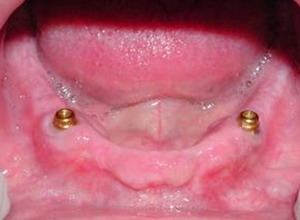
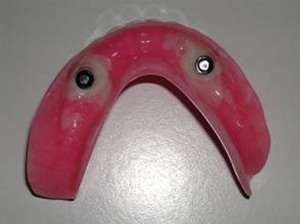
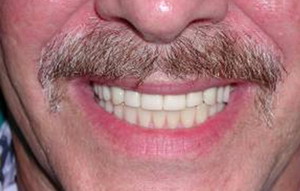
A free-standing lower overdenture using two implants
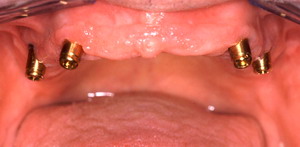
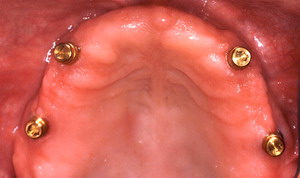

A maxillary free-standing overdenture using four implants and maintaining the palatal coverage of the denture


Lower free-standing overdenture using five mini implants
A bar-overdenture connects the implants with a lab fabricated bar. This allows the loads during chewing and functioning to be spread over all the implants and helps protect the individual implants. With a bar-overdenture the implants and bar not only retain the denture but also support the denture keeping pressure off the gum tissue. Attachments are in the bar and like those used with free-standing implants, they engage the portion in the denture holding the denture securely to the bar in the mouth.
Traditionally, bars have been fabricated using the lost wax technique, wherein the bar is fabricated in resin which is invested and after melting the resin out of the mold gold or suitable metal is injected to form the bar. This technique has its down sides, which include potential inaccuracies to fit from the casting process. In recent years, high technology has come to implant bar fabrication. Cad/Cam technology allows the bar to be created virtually and then milled from a solid block of metal providing a stronger more accurate bar. Cad/Cam bars may be milled from titanium alloy which provides high strength and 1/3 the weight of cast gold bars.
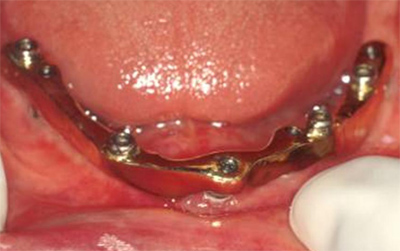
Mandibular cast overdenture bar with four attachments

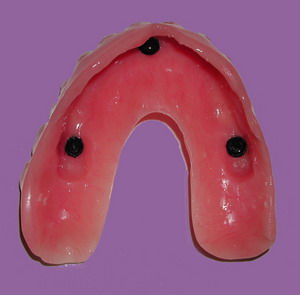
Maxillary Cad/Cam milled overdenture bar with three attachments and a palateless denture



Maxillary Cad/Cam milled overdenture bar with four attachments and a palateless denture
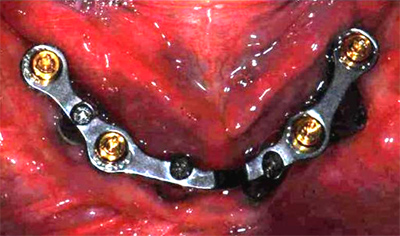
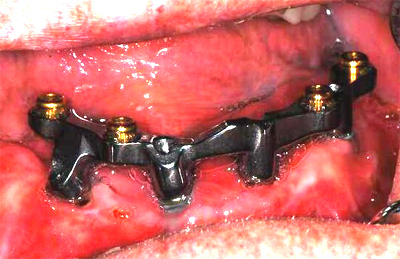
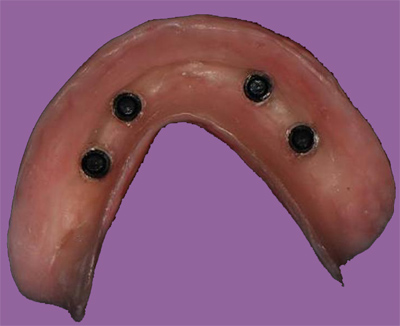
Mandibular Cad/Cam milled overdenture bar with four attachments
When is a bar-overdenture better then a free-standing approach?
Although use of a bar does raise the cost of treatment, there are sound clinical reasons when a bar should be used and free-standing avoiding. When significant loss of bone has occurred and there is insufficient ridge height to provide lateral resistance a bar is indicated. The bar in these cases prevents lateral stresses being placed on the individual implants and helps preserve the bone around them. If a bar is avoided in these cases bone loss may be seen over time on the implants leading to possible failure and loss of the individual implants.
Frequently when the patient desires to eliminate the entire palatal coverage by the denture a bar is best used. The bar is especially important in the upper jaw (maxilla) as the bone here is softer and the direction of load has greater potential to laterally load the implants.
If your current denture lifts up (or drops down) when eating or talking but does not slide side to side then a free-standing approach may be an option. But if the denture has side to side slide then a bar is the best approach in providing a secure result.
When is an overdenture a better approach then a fixed bridge?
As the upper anterior (front) teeth are lost, bone and gum tissue is also lost. In these situations missing structure needs to be replaced to properly support the lip and this may not be possible using a fixed approach. Additionally, home hygiene may be more difficult with fixed prosthetics compared with a removable approach.
Implant Cosmetic Dental Center™
----------------------------------------------------------------------------------------
Dr. Gregori M. Kurtzman is an international lecturer, selected as one of the top 100 dental speakers since 2006 by Dentistry Today, author of over 200 professional articles, a consultant to multiple dental manufacturers for product evaluation, development and research, he provides general dental care in suburban Maryland since 1986.
|
|
|
|
|
|
|
|
|